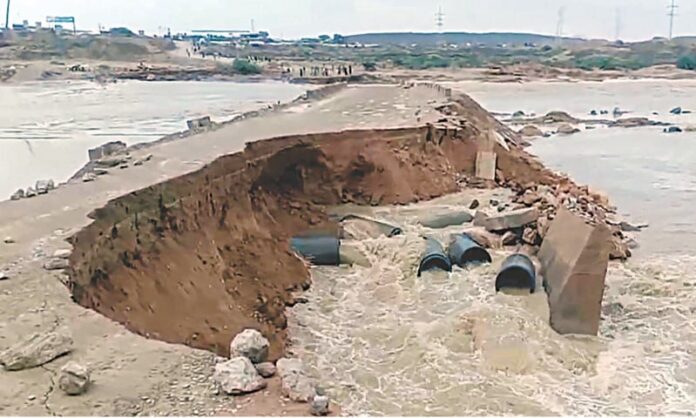GWADAR: Intermittent heavy rains have caused widespread destruction in Balochistan with Quetta and Gwadar flooded with rainwater while most areas of the province lost ground connectivity with other parts as roads and highways were washed away.
According to the Provincial Disaster Management Authority (PDMA), intermittent rain continued in Quetta and Gwadar regions since past two days, which has disrupted routine life and submerged all low-lying areas, suspending traffic on various important roads.
Due to the unprecedented downpour in Gwadar regions, highways also washed away and ground connectivity with Karachi and other Sindh areas was disturbed.
The SP Coastal Highway confirmed that traffic between Gwadar and Karachi has been suspended at Makran Coastal Highway near Princes of Hope as the road has been blocked by flood and other routes were also washed away.
In Quetta, it has continued to rain since last night and water entered the houses while highways and linked roads were closed for any traffic.
The downpour also badly affected the areas of Turbat, Panjgur, Noshki, Pishin, and Chaman as well. Reportedly, flooding caused roads to wash away in Chaman and rainwater entered houses, especially in the low-lying areas.
Heavy rainfall in Ziarat, Pasni, Ormara, Jiwani, and Jhal Magsi also led to flashflooding in streams and nullahs.
According to the PDMA report, numerous settlements in these areas have been submerged, and the roofs of many houses have collapsed while ground connectivity has also been disrupted in several villages.
Karachi was also affected by the westerly rain system as it experienced downpour in areas like Metrowell and SITE, Orangi Town, and Sher Shah.
In the early morning in Lahore, the weather became pleasant due to rain in different parts of the city.
The Meteorology Department has predicted heavy rains in Sindh and Punjab for the next three days as a spell of rains is expected from April 18 to 21.
As per the met office report, Khyber Pakhtunkhwa, Azad Kashmir and Gilgit-Baltistan will also receive rain during next three days.
The met office also confirmed that another spell of rain is expected from April 25 to 29.
As per the report, there are falling rains at nearly twice the historical average rate in April this year and at least 65 people have died in lightning and heavy rain incidents in Balochistan and other parts of the country.
Pakistan is increasingly vulnerable to unpredictable weather patterns, as well as often destructive monsoon rains that usually arrive in July.
“In April, we have observed highly unusual rainfall patterns,” Zaheer Ahmad Babar, spokesperson for the Pakistan Meteorological Department, told reporters.
“From April 1st to April 17th, we experienced precipitation levels exceeding the historical average by 99 per cent,” he added, citing data from the past 30 years as a comparison.
“Climate change is a major factor behind these unusual weather patterns and above normal rainfalls, but it’s not just Pakistan which is affected, the whole region is experiencing changes in temperature patterns,” Babar added.
In the latest rains, 21 people including farmers harvesting wheat were killed by lightning in Punjab, Pakistan’s most populous province, provincial authorities said.
At least eight people were killed in Balochistan province, including seven struck by lightning, where 25 districts were battered by rain and some areas were flooded.
At least four people were killed in road accidents linked to flooded roads in southern Sindh province.























